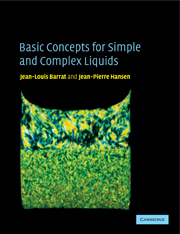5 - Critical fluctuations and scaling
Published online by Cambridge University Press: 06 January 2010
Summary
The mean field theories of phase transitions considered in the previous chapter explicitly or implicitly neglect fluctuations, i.e. local deviations of the order parameter from its most probable, macroscopic value. This neglect is epitomized in the basic assumption underpinning Landau's theory, i.e. that the order parameter is uniformly replaced by the value which minimizes the phenomenological Landau free energy; fluctuations around this most probable value do not contribute to the partition function (4.36). The fact that local deviations of the order parameter from its average are not built into mean field considerations means, a fortiori, that correlations between fluctuations occurring in different subsystems are neglected. Correlations on the molecular scale, as quantified by the density correlation functions or static structure factors introduced in section 3.4, dominate first-order phase transitions like freezing, and can be accounted for quantitatively within standard structural theories of dense fluids, like the mean spherical approximation (MSA) and Percus–Yevick (PY) approximation mentioned in chapter 3. The range of these spatial correlations is typically a few molecular diameters. However, upon approaching the critical point of a second-order phase transition, e.g. the liquid–vapour critical point, density fluctuations become correlated over mesoscopic scales, while the macrosopic response of the system (e.g. the compressibility) diverges. A quantitative description of large-scale fluctuations is a highly challenging problem which has only been understood since the 1970s in terms of the idea of scale invariance, one of the key concepts of this chapter, which may also be applied to other, apparently unrelated, ‘critical’ objects like polymers.
- Type
- Chapter
- Information
- Basic Concepts for Simple and Complex Liquids , pp. 143 - 166Publisher: Cambridge University PressPrint publication year: 2003



